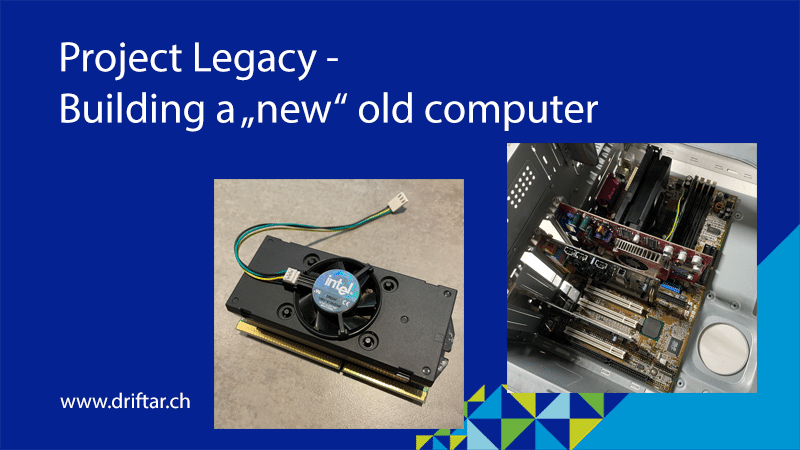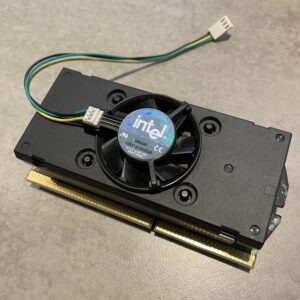Yes, you’ve read that correctly. The title is confusing. I’m building a new old computer. Usually, something is new or old, but it can’t be both. But this time it is indeed both. It’s not directly Schrödinger’s computer, both old and new at the same time. But I think you’ll get the point.
Before we go into this topic: it has nothing to do with virtualization. Well, technically. But first things first.
Many moons ago I stumbled across some Tweets (that was before it was called X) of people gathering old hardware. Pentium III CPUs, old graphics cards like the Voodoo series, or Creative SoundBlaster sound cards. And for sure the very legacy beige computer cases. The good old stuff we all remember. The seed of building such an old computer has been planted a long time ago. And it germinated, grew, and now the young plant is blooming.
I didn’t start directly with gathering hardware and buying shedloads of old stuff. No. I first did some trial & error in my vSphere homelab. Yes. You can install Windows 98 as a virtual machine on your vSphere environment. I’m not saying you should, but it’s possible to do so. Unfortunately, you won’t have sound output, at least as far as I was able to test. So I moved on and set up a virtual machine on VMware Workstation. After installing the right sound driver, there was that iconic Windows startup sound. Oh, how I loved it!
(Original source: YouTube.com)
What’s next?
After the first steps with the old operating systems (Windows 95, Windows 98 Second Edition, Windows Millenium Edition, and Windows 2000) as VMware Workstation and VMware vSphere virtual machines, it was time to think about the goals:
- What do I want to do with that old computer?
- What hardware do I need to reach my first goal?
- Where do I get the components?
- How much will it cost approximately?
- Is it really worth it?
To answer these questions shortly…
One of the goals was playing the good old games from back in the day. Games I grew up with, like the very first Anno 1602 game, or the classics of Command & Conquer (like Tiberian Dawn and Red Alert). I played them for hours and hours and I loved them.
Before I started to search for hardware, I tried to find out what hardware would be required. I wanted a Slot 1 CPU, not a socket CPU. This requires a suitable mainboard. And with a Slot 1 CPU, you can’t go too high with the CPU clock. I was limited to 600 MHz. Also, depending on the operating system (I wanted to install Windows 98), I was limited with memory. I didn’t want to go too high, but also not too low. So something at around 256 MB of memory should fit the bill. In regards to graphics, I wanted to go all in (kind of). It should be a GeForce graphics card because the first real gaming graphics card I had was a GeForce 256 with voxel technology. I can’t help it, but I think the Creative SoundBlaster sound cards are still the best when it comes to this sort of thing. And of course, it’s a must to have one of these good old beige-colored computer cases.
It took for sure more time to find out what hardware I needed than just to write it down here in this blog post. It required my brain to go into its archive and it required a lot of googling things. All the things and terms that are almost extinct today, like AGP, DMA, front side bus, etc. Damn, I knew that by heart back in the day!
When I started searching for that hardware, I came to the conclusion that in Switzerland, my home country, not much is available. There are roughly 8.7 million people living in Switzerland. And I bet, only a handful of nerds like me that still have (or want to have) such old hardware. Okay, maybe you can use both hands for counting. But on the Swiss sales and action platforms, there wasn’t much. All I found was a CPU (which I then finally used for the project) as well as a floppy drive, the hard disks, and the required cables. Recently, I stumbled across a joystick in Switzerland too.
The rest of the precious hardware I ordered was all from the United States and from Germany. There are obviously way more nerds like me 🙂
Bill of material (BOM)
I know you are eagerly waiting for the BOM. What did I buy exactly, and what did it cost? Some bucks, at least. But the following table shows you these bucks in detail. The costs are not approximate but even pretty accurate.
| What is it? | What did it cost? (currency rate from 19. Sept., 08:51 UTC) |
| ATX computer case | CHF 195.- / USD 218.- |
| Mainboard (ASUS P3-F Slot 1, AGP) The set included:
|
CHF 145.- / USD 162.- |
| Creative SoundBlaster AWE64 Gold ISA | CHF 155.- / USD 175.- |
| Gainward GeForce 4 Ti 4800 64 MB | CHF 167.- / USD 187.- |
| ATX Power Supply | CHF 63.- / USD 70.- |
| Pentium III 600 MHz 512 KB cache | CHF 36.- / USD 40.- |
| Creative CD Rom Blaster 52x (yes, that’s the CD Rom drive) | CHF 67.- / USD 75.- |
| 3.5″ floppy drive | CHF 16.- / USD 18.- |
| 60 GB IDE hard disk | CHF 28.- / USD 31.- |
| IDE and floppy cables | CHF 6.- / USD 7.- |
| PS/2 keyboard (an old but brand new IBM keyboard) | CHF 117.- / USD 130.- |
| PS/2 mouse | CHF 14.- / USD 15.- |
| Shipping costs (total) | CHF 380.- / USD 425.- |
| Total: | CHF 1389.- / USD 1553.- |
Is it really worth it?
It depends 🙂 Some may say it’s not worth it because of this or that reason. And these reasons may be legitimate. Some others, like me, may say that it’s worth it. I call it memories. I call it learning. I call it the good old times. I call it a hobby. So yes, it was worth it, at least for me.
Some images
Feel free to browse the following images of that “new old” computer.














